This is an AGFA Parat I, a 35mm half frame camera made in West Germany between the years of 1963 and 1968. The Parat I was the most basic model in AGFAs Parat lineup of half frame cameras, which also consisted of the Paramat and Optima Parat which both featured shutter priority automatic exposure. It is a compact and lightweight camera that was released at a time when there was a resurgence of interest in half frame cameras. Although in production for 5 years, the Parat series wasn’t very successful, so there was never a Parat II or any models other than the two already mentioned. Despite it’s stance as a cheap camera made almost entirely of plastic, the Parat I’s ability to manually select shutter speeds means it is more likely to work today, than the other two models which were dependent on the selenium cell exposure meter.
Film Type: 135 (35mm) Half Frame 18mm x 24mm exposures
Lens: 30mm f/2.8 AGFA Color Apotar coated 3-elements
Focus: 3 feet to Infinity with reference icons for Portrait, Group, and Landscape shots
Viewfinder: Scale Focus
Shutter: AGFA Paratic Leaf
Speeds: B, 1/30 – 1/125 seconds
Exposure Meter: None
Battery: None
Flash Mount: Hotshoe with M and X Flash Sync
Manual (similar model): http://www.cameramanuals.org/agfa_ansco/agfa_paramat_18x24.pdf
History
The AGFA Parat I is a “half frame” 35mm camera produced in the 1960s during a brief “renaissance” of the half frame format. For anyone whose never seen a half frame camera, there is nothing special about the film used in it. Half frame 35mm cameras like the Parat use the same exact 35mm film as a “normal” 35mm camera, it just shoots images that are 18mm x 24mm, or half as big. The benefit being that you can get double the number of exposures per roll. If you put in a 24 exposure roll, you’ll get 48, a 36 roll will get you 72 and so on.
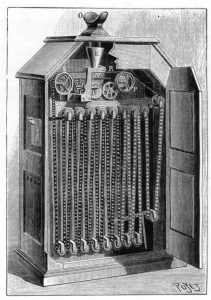
I mention the 1960s as a renaissance because the origins of “half frame 35mm” predate most regular 35mm cameras. The first widespread use of 18mm x 24mm images was in a motion picture projector called the Edison Kinetoscope, developed by Thomas Edison and W. K. L. Dickson in the 1890s.
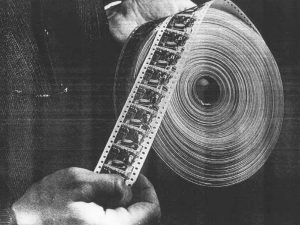
The 18mm x 24mm size was used as a side effect of the film stock that Edison had chosen to use in his projector which was 1 ⅜ inches (34.925mm) wide with perforations on either side. Since the image couldn’t overlap the perforations, the image was recorded in the middle part of the film which was about 24mm wide. Edison wanted his images to have a 4:3 aspect ratio, so that meant each image had to be about 18mm tall.
Edison’s Kinetoscope was very popular and inspired many other companies to make motion picture cameras using similar film stocks. As the 20th century started, more and more companies adopted the 18mm x 24mm image size and by 1909, Edison had founded the Edison Motion Picture Patents Company to define this type of 35mm film stock as the standard for all cinema cameras.
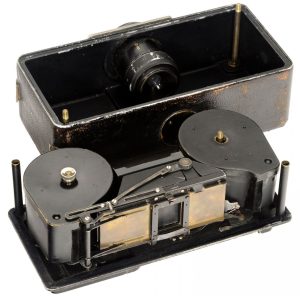
Around this same time, several inventors such as Jens Poul Andersen, a Danish inventor who in 1905 created a couple prototypes that would capture up to 300 still images on a roll of cinema film 20 meters long. Most of these early still film cameras existed in prototype form only and were not sold to the public, at least in high numbers, and very few are known to survive today. As with the experimental nature of prototypes, the exact film and image size of the exposures varied wildly.
Over the course of the next 2 decades, a huge number of still film camera designs were made, some only in prototype form, and some mass produced, that all used the same Edison cinema film and shot images in 18mm x 24mm, 24mm square, 24mm x 36mm, and many other sizes.
In 1914, Oskar Barnack while working for Leitz, would create a device that was intended to work as a cinema film tester. Barnack was asked to develop a motion picture camera for Leitz and in an effort to accurately calibrate the shutter of the motion picture camera to the film stocks of the day, he created what would later be known as the Ur Leica which could use a snippet of a stock of cinema film and expose a single “double image” that was 24mm x 36mm in size for calibration purposes. Although the Ur Leica was not originally intended to be used or sold as a still picture camera, that’s what ended up happening, turning the Leica into one of the most important still cameras in the history of photography.
By the 1930s, with successes like the Leitz Leica and the Zeiss-Ikon Contax who used Edison cinema film and shot 24mm x 36mm images, the popularity of 18mm x 24mm “half frame” cameras started to diminish. The final nail in the coffin occurred in 1934 when the Eastman Kodak company released their new 135 format 35mm film that standardized 35mm cinema film, following Edison’s original standards, into a daylight loading cassette. 135 format film would quickly become the preferred film for all 35mm still picture cameras, and has continued on ever since as the most popular film format ever. By the end of World War II, there were very few half frame cameras still in production leaving the format all but dead…
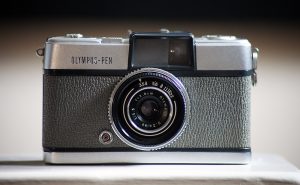
But then in 1959, a funny thing happened. Photography was getting cheaper and more accessible to amateur photographers, and in an effort to create value for this new subset of photographers, the Olympus Optical Co., Ltd. of Japan released a new line of cameras called the Pen series that shot 18mm x 24mm half frames. The Pen camera was designed to be as small as compact as possible. The name “Pen” was taken as the camera was said to be as portable as a pen.
The Olympus Pen was an immediate success as it allowed consumers to get twice as many exposures per roll of film. This success enticed many Japanese and German companies to release competing half frame models. By the early 1960s, almost every camera company from AGFA, Canon, Minolta, Fuji, and Yashica had released a competing half frame model. Even Nippon Kogaku had created a prototype of the Nikon F SLR that shot half frames, but it was never offered for sale.
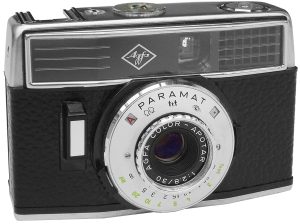
For their part, the German company AGFA created a line of inexpensive cameras called the Parat which were based off the design of the full frame Optima series. The fact that AGFA designed the Parat series in the larger Optima body suggests they weren’t really that invested in the format as there’s no reason that the Parat needed to be the same physical size as a full frame 35mm camera. Most of the Parat series cameras had auto exposure via a selenium cell meter. This was thought to be an ideal combination for a novice photographer as it combined the simplicity of automatic exposure, with the economy of a half frame camera.
In an effort to cater to everyone, AGFA had a base model called the Parat I which is being reviewed here. It was like the higher end Paramat and Optima Parat, except it lacked an exposure meter and it’s automatic modes. Instead, it offered a simple 3 speed shutter with speeds of 1/30, 1/60, and 1/125. I could not find any information about how successful it was, but my guess is “not very” as there was never a Parat II, and the whole Parat series would last only 5 years, being discontinued in 1968.
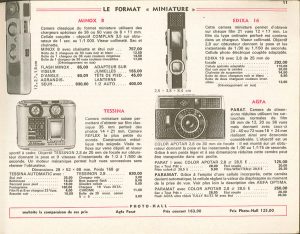
Finding any sort of information about the Parat/Paramat series was quite hard. The only type of advertisement or literature I could find is a French language page from some type of catalog. In the image to the right, you can see that the Parat sells for exactly half the price of the auto exposure capable Paramat camera. It would be nearly impossible to attempt to convert a foreign currency from the 1960s into American dollars today, so to get an approximation of what these cameras might have sold for in the US, I looked up the full frame Optima, which this camera was based off. In the early 60s, the Optima regularly sold for a list price of $79.95. If AGFA sold the half frame Paramat for the same price as the Optima, and consistently sold the Parat I for half the price of the Paramat, then that would suggest the Parat I probably had a list price somewhere around $39.95 which would have put it right at a price point of other similar entry level cameras.
Today, some half frame 35mm cameras like the Olympus Pen series are quite collectible due to their novelty, but the AGFA Parat series is relatively unknown and the Parat I even less so. I doubt many of these were made as the half-frame craze of the 1960s came and went pretty quickly. The companies with the most success with it were Olympus and Canon, so I see these models by AGFA as merely a half hearted attempt to offer something in the segment.
My Thoughts
With the exception of the original Olympus Pen, most of the cameras released during the resurgent popularity of 1960s half frame cameras, were pretty basic models. These cameras were aimed at the economic photographer who wanted to maximize their value by shooting twice as many images on a roll of film.

These cameras came out at the same time that auto exposure cameras were gaining traction with novice photographers, so a large variety of half-frame cameras were designed to use a selenium cell meter to calculate exposure. The manufacturers felt that by combining the ease of AE with the value of a half-frame camera, they’d have a winner.
And they were right, mostly. If you look at most of the half frame models made by Olympus, Canon, Ricoh, Fujica, Minolta, and AGFA, most of them had basic shutters, sometimes with only a single speed. Usually settings like shutter speed and aperture size were not even controlled by the user, rather the camera was AE exclusively.
This poses a problem for collectors today as these cameras are all over 50 years old, and the selenium cells needed to make auto exposure work are often dead or dying, rendering the camera unusable. Sometimes you can salvage some use out of the camera by forcing it into a special mode for flash photography, but otherwise, many of these models become display pieces.
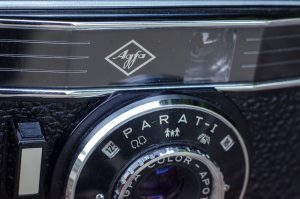
The Parat I is one of the few half frame cameras to not have any type of auto exposure mode. It was sold as an entry level camera that did not offer automation and required the photographer to manually set shutter speeds and aperture. At the time, the number of potential customers was probably pretty low as there wouldn’t have been many people interested in the value of half frame images, but were still willing to calculate exposure themselves. The fact that this model is called the Parat I and there was never a Parat II suggests that the model didn’t sell well. In addition, these cameras rarely show up for sale, which is further evidence as their scarcity.
As fate would have it, the lack of a meter and any sort of automation, turned out to be a blessing for the long term viability of the Parat I as there is little to go wrong with the camera. Sure, it could have any level of damage due to misuse, storage, moisture, mold, or any other maladies that often prevent old cameras from working, but assuming everything was in good order, the Parat I has a better chance at working than most 1960s half frame cameras.
I picked up this camera in a lot of other goodies I received late last year and I was pleased to see that it was in good working order. The shutter fired at all 3 speeds, the glass and viewfinder looked good, and everything else about the camera seemed to be in good working order.
The Parat I was the entry level of a line of budget cameras, and this fact is very evident the first time you pick it up. The camera employs quite a bit of plastic in it’s construction. By the 1960s when this camera was made, the widespread use of more robust plastics like Bakelite had given way to more cost effective and lighter weight molded plastics like we see today. Without film loaded, the Parat I weighs 297 grams, making it one of the lightest non point and shoot cameras in my collection.
The good news is that AGFA clearly maintained some level of build quality with the camera because despite it’s svelte weight, the Parat I does not feel cheap in your hands. There aren’t any excessive gaps in the plastic, and the camera does not creak in your hands upon normal use. I also quite liked the deeply textured body covering which has a slight rubberized feel to it, improving grip compared to the more plasticky feel of other inexpensive cameras.
The viewfinder is small and the half frame gives a cramped feeling, not unlike the smaller direct viewfinders of other 35mm cameras from the 40s and 50s. Since there is no meter, there is no readout information in the viewfinder, not even projected frame lines. I was going to provide a through the viewfinder image for this review, but there is nothing to see other than a rectangle image.
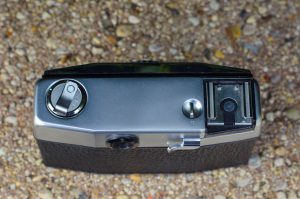
The top of the camera is rather bare, featuring only the folding rewind crank, a flash hot shoe and a button which activates rewind mode for when you reach the end of your roll of film. I could not find a manual for the Parat I, but the Paramat’s manual suggests that electronic flashes can be used. I assume that the camera is flash synchronized at all speeds, but I did not test this to confirm.
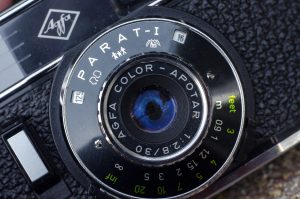
Both shutter speed and aperture sizes are on the front of the camera and are changed via a slider on the left and right sides of the shutter. Although conveniently located, the slider for the shutter speed is very close to the shutter release and can be hard to move without fumbling around. The shutter release is threaded for a shutter cable if you so wish to use one.
Focus is controlled by rotating the front element. There are two scales, one showing distance in feet and meters, and the other showing scenes (portrait, group, and landscapes). The feet and meter scale is conveniently upside down, which makes seeing it with the camera to your body easy.

On the bottom of the camera is the exposure counter which resets manually, a plastic tripod socket, and the release for the film compartment.
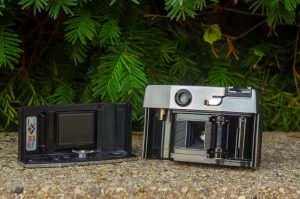
When you open the film compartment, there is no hinge, the back comes completely off revealing an all plastic, but otherwise ordinary film compartment. Film loads from left to right, and the advance lever is on the back of the camera. I found that I was able to secure the leader on the take up spool with one advance of the film lever, which suggests I should be able to get at least one extra exposure out of a roll of film.
The Parat might be a basic and low end camera, but it has everything you need to capture good images outdoors. Despite being mostly constructed of plastic, the quality is there where it matters most, which is the lens. If you can find one of these little guys in good working condition, you could have a fun and extremely portable half frame camera to play with.
My Results
My first opportunity to use the Parat came during a June trip downtown Chicago with my friend Mark Faulkner from the Gas Haus. We walked around the loop shooting various city scenes. I used a roll of Ultrafine 100 black and white film. I chose the Ultrafine as it was a 12-exposure film and with the half frame camera, I would still get 24 exposures, like I would have with a 24 exposure roll in a full frame format.
I figured the shadowy areas among Chicago’s skyscrapers would be a good match for the Ultrafine 100 film and the Parat’s limited shutter speeds. My plan was to keep the camera at 1/125 for most of the roll with the occasional shot at 1/60 in heavy shadows. With only 3 shutter speeds available to me, I made a point to avoid any types of fast motion shots.
Since half-frame cameras cut a normal 35mm frame down the middle, you end up with a camera whose default orientation is portrait. This means that unless you turn the camera 90 degrees to the side, you are more likely to compose more shots in a portrait orientation. This isn’t really a problem, in fact, by defaulting to a portrait orientation, it forces your mind to compose images differently than with a regular 35mm camera.
I quite liked the experience of shooting with the Parat. Sure, the controls on the front of the lens left a bit to be desired, but since I kept the shutter and aperture settings mostly the same throughout my first roll, it was rarely a problem.
My choices for exposure were right on, suggesting that a 100 speed film is a good choice for a camera like this. I would have really struggled had I attempted to use this camera indoors or at a race track or something with a lot of fast motion. The Ultrafine film has a bit more grain than I had expected for a 100 speed film, but still turned out nice images that when kept to a reasonable size, are quite sharp and show a good amount of contrast.
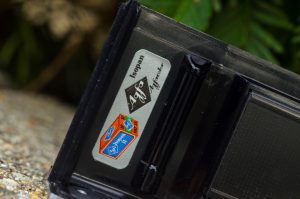
When used to it’s strengths, the little Parat is quite a fun little camera. The lens is quite capable. Even though a half frame camera has half of the area as a full frame 35mm image, when viewed on a computer screen, the images still look sharp and nicely defined. I likely wouldn’t ever print any of these images, but I feel confident they would look fine at 4×6 or even 5×7, but I probably wouldn’t go any higher than that.
It’s a shame that AGFA didn’t find it necessary to design the Parat with a more compact body as the Optima chassis it’s based off is unnecessary for such a small camera. It would have been interesting to see how small this camera could have been had it had a unique body. Despite this, it’s still very portable, and its sub 300 gram weight means you can slip it into a pocket and forget it’s there.
This is a pretty rare camera, and although the Paramats are a bit more common, the possibility of a dead meter and lack of manual control make those cameras less likely to be usable today. This is one occasion where a models simplicity was it’s saving grace. This isn’t likely to be a camera I’ll take out on a regular basis, but the appeal it had back in the 1960s is still there today. I have a very compact and handsome camera that gives me the economy of twice as many exposures per roll, easy to use controls, and a very nice lens.
My Final WordHow these ratings work |
The AGFA Parat I is a nicely designed and capable half frame 35mm camera from a brief period in the 1960s when half-frame cameras were in vogue. Although positioned as an entry level camera and built with quite a bit of plastic, the camera never feels cheap. It is easy to use, very lightweight, has a really solid lens, and does not rely on a selenium cell exposure meter to work. These cameras are quite uncommon, so may be hard to find, but if you’re in the market for a 1960s half frame camera and want manual controls, this is one of your only options. | ||||||
| Images | Handling | Features | Viewfinder | Feel & Beauty | History | Age | |
| 1 | 2 | 0 | 1 | 1 | 0 | 20% | |
| Bonus | +1 for the camera being greater than the sum of it’s parts | ||||||
| Final Score | 7.0 | ||||||
Additional Resources
http://vintagecameralab.com/agfa-parat-i/
https://www.lomography.com/magazine/11949-agfa-parat-i-half-frame-full-camera
http://camerapedia.wikia.com/wiki/Agfa_Parat_%26_Parat-I
http://camera-wiki.org/wiki/Parat-I
http://www.collection-appareils.fr/x/html/appareil-13044.html

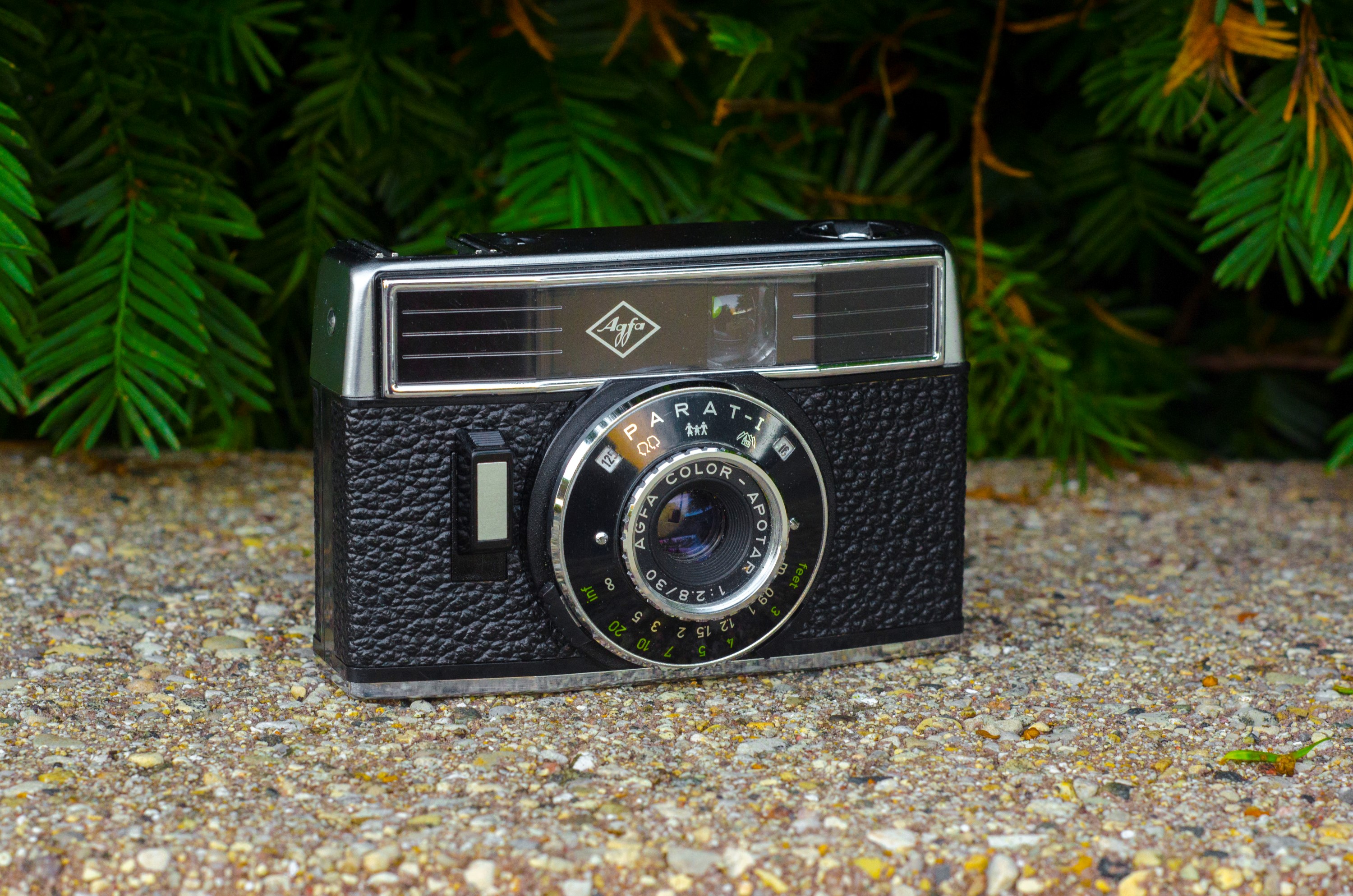
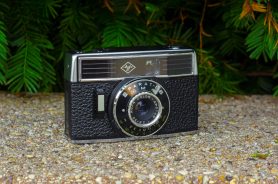









It is often written that the Agfa Parat Seriens is the same size as Agfa Optima 500 or Agfa Silette Record. But some Pictures on the internet, with filmrolls near the cameras, suggest, that the Parat Series was just the same design, but smaller than the fullframe 35mm models.For me, it doesn’t seem to be much bigger that a Olympus Pen.
Very nice review, thanks. The “french language catalog page” seems to come from a swiss shop in Geneva (Photo-Hall, still existing today). At the time (1960), 1$ was about 4.3 CHF, so Photo-Hall had a good deal of about 29$. But the page footer mentions Regular price 163, that would be about 38$.
I once had a lengthy talk with Alan Dwan about his early hostile encounters with Edison Motion Picture Patents goons
Does your copy have a serial number? I don’t see a serial number anywhere on my Parat-I. This is not unheard of, but seems unusual to me, especially for a German company.
Hi Charles, I took a look at my Parat I (I am amazed I was able to find it so quickly!) and could not find a serial number anywhere on it. There is nothing on the body, lens, shutter, or in the film compartment. I agree that’s strange as most companies had serial numbers on their cameras. I guess I will not be itemizing this on my homeowners insurance! 🙂